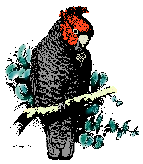Joe Forshaw has pointed out that
for the Cooper illustration I wrongly looked at Cooper’s male bird 2.
rather than bird 1. The point being that bird 2., with the pale blue eye ring,
is the western subspecies, that particular eye ring colour being what separates
the two subspecies.
The corrected table is below,
looking more consistent. The significant local observation remains, I
think, the absence of any pink or red irises in my sample. Joe suggests
that the large flocks in Canberra, as for other cockatoos, are made up mainly of
sub-adult birds together with a few old, partnerless, territoryless birds,
these being more likely males. This would explain the sample of eye
colours previously circulated.
We discussed this while watching
a small flock of Galahs excavating a median strip. We were on our way
with Don Brightsmith to find a Glossy B-Cockatoo – a mission that met
with a notable lack of success, despite a longish walk.
However, speaking of pinkish, we
did manage to find a Freckled Duck with some breeding colour on FSP, Pond 6.
From: Geoffrey Dabb [
Sent: Monday, 14 July 2008 4:27 PM
To:
Subject: [canberrabirds] Common Canberra birds No.1
Galahs seem to be the bird of the moment. For the last
GBS year they topped the abundance table. Last week there were thousands
around the streets of South Canberra, but this week there are not so many on my
beat. [This is possibly because the rain
softened the ground last week. They were feeding on grass rootlets.]
All this since the 1950s when the Galah was an infrequent wanderer to
the ACT. Ageing and sexing these birds does not seem to quite so simple
as has been suggested. I have gleaned the following from the references
to hand (‘Forshaw’ being ‘Australian Parrots’ 2nd
rev ed).
Forshaw
|
|
Adult male
|
Adult female
|
Immature
|
|
‘Periopthalmic ring’
|
Dull crimson
|
Similar
|
Pale grey, slightly tinted pink
|
|
Iris
|
Dark brown
|
Pinkish red
|
Brown
|
Cooper illustration
|
|
Adult male (from ‘Gungahlin’)
|
Adult female
|
Immature
|
|
P ring
|
Pink
|
-
|
|
|
Iris
|
Brown
|
-
|
|
HANZAB
|
|
Adult male
|
Adult female
|
Immature
|
|
P ring
|
Pink-dark pink-pinkish red
|
Similar, carunculations smaller
|
(possibly) pale yellowish-pink
|
|
Iris
|
Black-brown
|
Pink-orange pink-red
|
Not fully pink until 2/3
|
HANZAB illustration
|
|
Adult male
|
Adult female
|
Immature
|
|
P ring
|
Pink
|
Pink
|
Pale pink
|
|
Iris
|
Dark
|
Yellowish-pink?
|
Dark
|
Yesterday and this morning I snapped about 50 individual
birds in Narrabundah and Griffith. By later editing the snaps I could bring up the
colour of all but the darkest eyes. Such editing was at the expense of
the aesthetic qualities, but I tried not to distort the colour. Nearly
all irises were a pale muddy brown. I could find none that I would call
‘pink’. There were a small number of obvious juveniles, still
with grey patches. Here’s an example, note eye colour:
There were a couple of very dark eyes that I took to belong
to old males eg (lightening revealing just a trace of light pigment in
the iris)
I take this to be either a female or, more likely, a sub-2
yr bird:
The colour of the ‘periopthalmic ring’ is
something of a problem because the appearance seems to depend on how knobbly it
is. Against the blue-grey background there are little peaks of pinkish
pigmentation and the size and structure might depend on age as much as
sex. This is probably a male from the ‘carunculations’, and
it looks old:
My conclusion - little more than a guess based
on large opthalmic rings and dark eyes being
the exception – is that there a lot of immatures (less than 3 years) in
these flocks, perhaps 70-80%.

